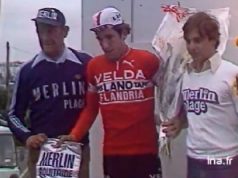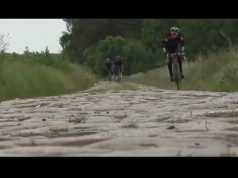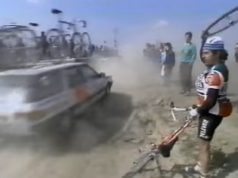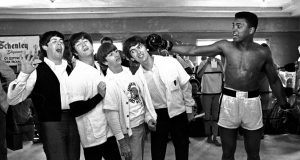By A.P. O’Máille
Dubliner John Brady turned professional in 1988 and procured a contract racing on the famous 7-Eleven team, a US based professional team that had a roster including Davis Phinney, Andy Hampsten, Sean Yates, Bob Roll and many other big name racers.
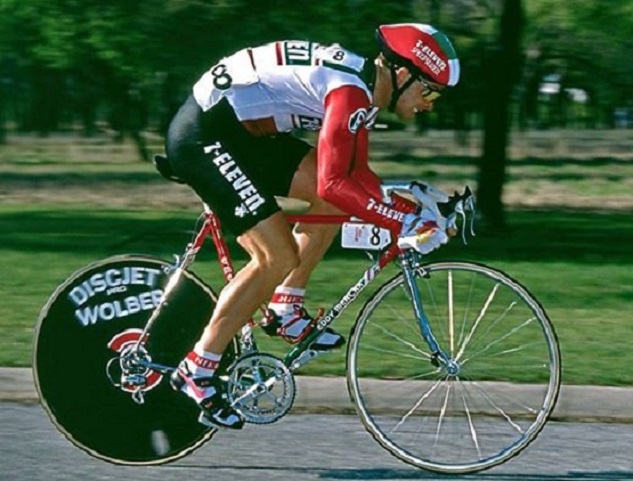
In 1989 he beat Greg LeMond. Here’s an article from the Los Angeles Times from twenty-five years ago:
CYCLING TOUR OF PALM SPRINGS: Brady Sprints to Win Second Stage Road Race October 22, 1989
John Brady of 7-Eleven sprinted away from a pack of riders Saturday to win the 75-mile second stage of the Tour of Palm Springs bicycle race in 2 hours 45 minutes 29 seconds.
Brady, 24, of Dublin, credited teammate [Norm]Alvis for helping him into position to win. A group of cyclists, fighting strong desert winds, were bunched through most of the race. Breakaways were short-lived, and leaders were quickly swallowed by the group. Brady, regarded as an excellent sprinter, followed Alvis through the pack, then sprinted about 50 yards from the finish.
Brady finished second in road races in St. Louis and Ohio the last two weekends, but just ahead of Greg LeMond, last summer’s winner of the Tour de France.
When did you get your first pro win and where? Was it a sprint finish?
1988, Tour of Texas in Zilker Park in Fort Worth. It was a circuit race, 3K a lap and we had to do thirty-five. There was a cross wind from the start and we broke the field into a group of forty guys. My timing was way off on this occasion. I usually start my sprint as late as possible.
Sprinting is a format that can be somewhat effortless, if done right. Generally, sprinters use other riders, as they Pavlovian “salivate”, towards the line!
The position you start your sprint is critically important, but this sprint was different, a strong cross wind changed everything, so at 250 meters I made my move rather than run the risk of getting “boxed in”. No one followed my wheel, and I got a gap of 25-30 meters with my head down, going as hard as I can go. With 100 meters to go, I looked around, put my hands up, and realised they were closing fast.
With the pack bearing down on me, I dived back down on the handlebars, but it didn’t matter, I “scraped” my way across the line, and got the win. The photo doesn’t quite show it, but I was about to dive for my handlebars! An almost amateur first win, for the start of a professional career!
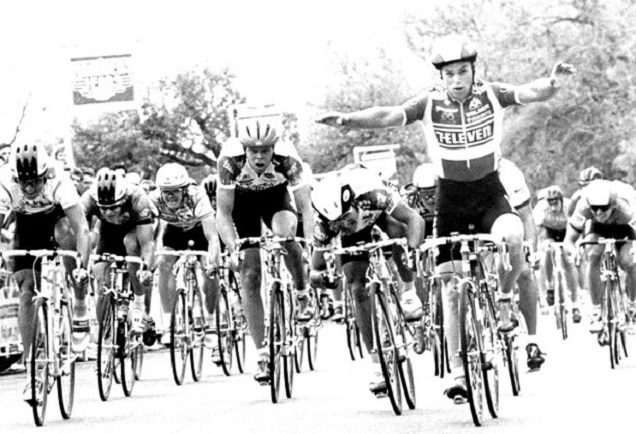
When you turned pro in the eighties, what were the factors that most influenced your training?
I gravitated towards road sprinting, of which there was a lot of in the US, in the late 80’s. I knew I had the speed but wasn’t quite strong enough, but knew I had time to develop. A big factor was I had ten years racing experience already in my legs, mostly in Ireland.
Sprinting is a chess game, predicated by speed and explosive strength. It’s a game with a few crucial moves that you need to execute at the right time, instinctively.
Racing for all those years, as a kid helped me learn from my mistakes, and there were many mistakes! By nineteen or twenty, I had a long list of “what not to do!”
Also, the weather in Los Angeles really suited me, as did the style of racing. Although at first, the weather was very hot 110 F (43 C) and took some getting used to. When I first arrived in America I was getting my ass handed to me – and lucky to get into the top twenty. This forced me to reassess the situation.
At twenty I made a momentous shift. Instead of looking at the external factors I looked at the internal ones. I saw myself, my body as an internal battery, a heavy battery that needed an increase in energy. I embarked on a Spartan training schedule – predicated on the body. I threw almost every piece of advice about cycling I’d read in magazines or heard, out the window.
I built a new routine based on some key factors:
1) Diligent and methodical, detail oriented and obsessive about gears, and my breathing during training and racing.
2) Schedule – what is the premise for improvement? I had to manipulate the body to a maximum amount, stressing it to the extreme and then recovering to the extreme – I got good at separating these two. So I tuned in to my body and asked: “Are you lazy or tired; mentally or physically tired?” This pendulum had to go full cycle: stress/recovery to stress/recovery and so on, like adapting to prison camp conditions.
3) Keep close to the soil! – I ate less processed foods and focused on fruit, meat, fish and non-processed food. I could never get my head around the so-called carbo-loading. I became obsessed with my weight, as I’d always been racing a little heavy. I’d train before breakfast, for 30-60km, then eat breakfast and do another 100-180km. I would pack sandwiches of cheese, jam, honey and bananas. I didn’t believe in the “canned” preparation of nutritional sports aids like Cliff Bar and Power Bar (though I do now). I’m still convinced these nutritional sports aids have nothing to do with winning bike races.
While I think nutrition is overstated, bad nutrition won’t help you.
I had a Eureka moment on the importance of food. For the most part it’s just a fuel you shove into your body. The real magic is in the chemistry of the body itself, not the food. In this regards, a trained body will turn normal food into an elixir.
Today people are busy buying training advice and packages from the likes of Chris Carmichael. As we know today, a lot of these training packages are bullshit. The whole foundation and science has been built on guys injecting EPO and doping products!
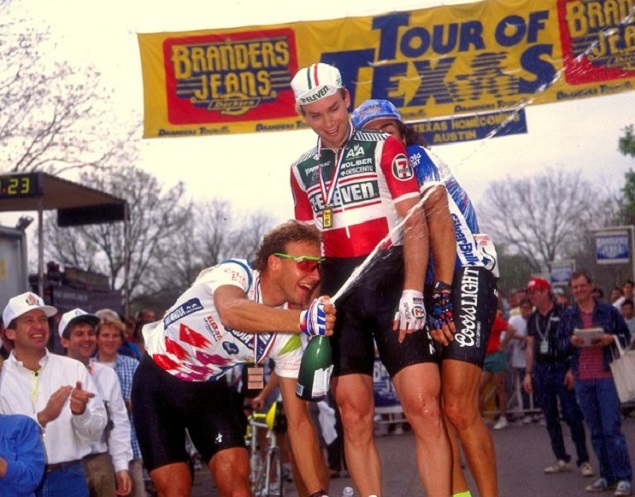
As a racing cyclist myself, I notice that as the bikes have gotten lighter, the bike handling skills have become scarcer, would you care to comment?
Bike racing today versus the 1980s has changed with the amount of information available, huge amounts of information/data, is a distraction. There’s no point in taking heed in any of this data, if you aren’t prepared to to question, learn and focus on the basics.
You need to get to the “meat and potatoes” of the equation – pushing the pedals – learn how to push the pedals harder. Asking the most basic questions about what it is you’re doing, for instance, how do you transfer core energy to the legs? The seat is a stabiliser for the core; the handlebars are more than just for steering: they are for leverage as well. What about breathing and position for leveraging gears etc: to elaborate on these topics would take a book, or two!
What are the major differences between racing in the US, versus Europe? Ireland?
Simple – speed. The roads are better [in the US] and the races shorter.
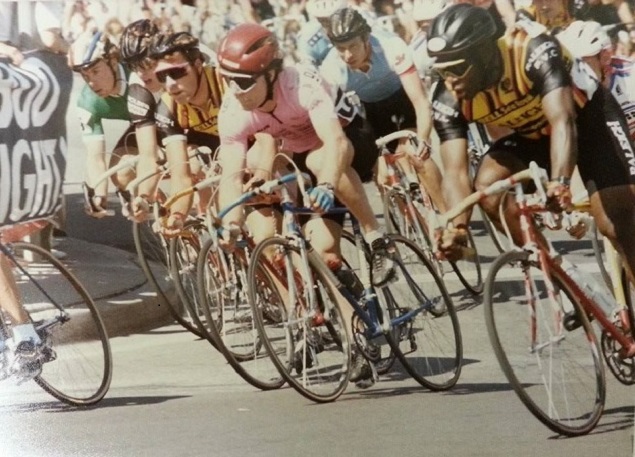
Part II of this interview with John Brady will appear in the next couple of days, where he talks about, amongst other things, his influences and retirement.

